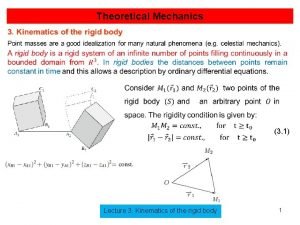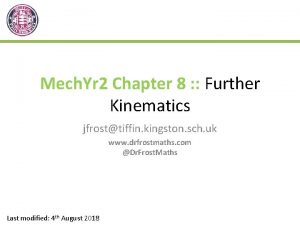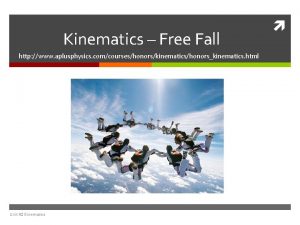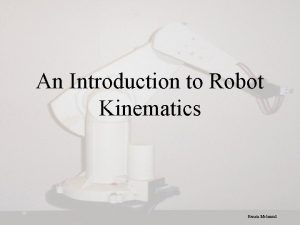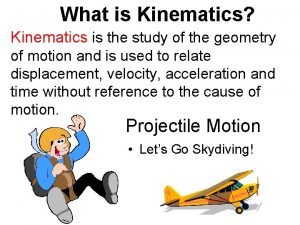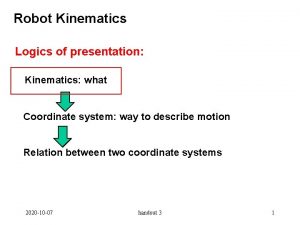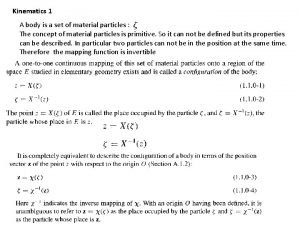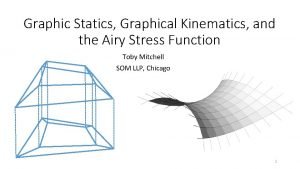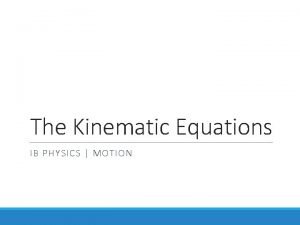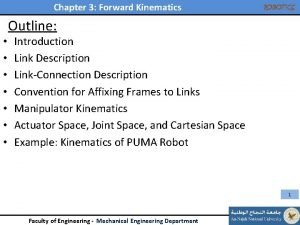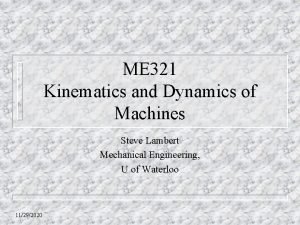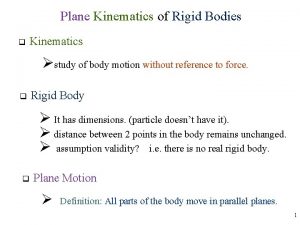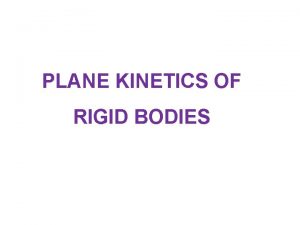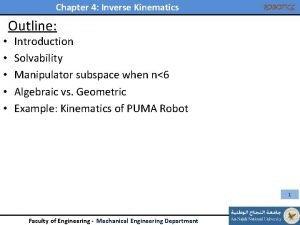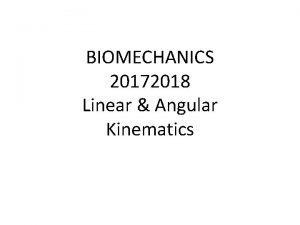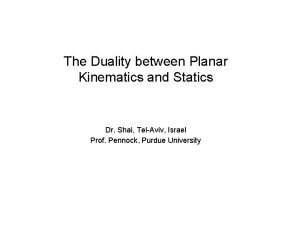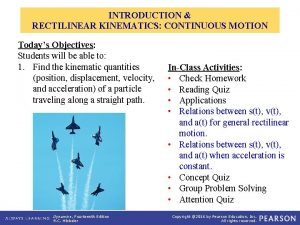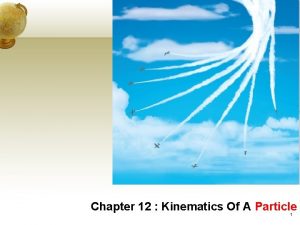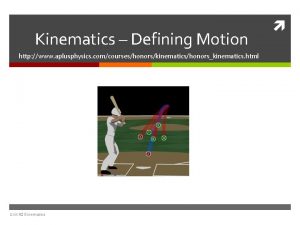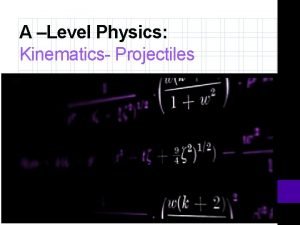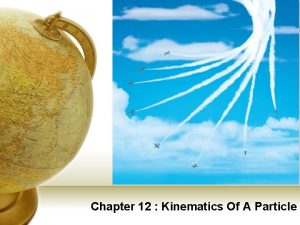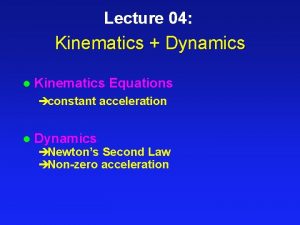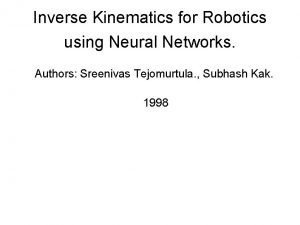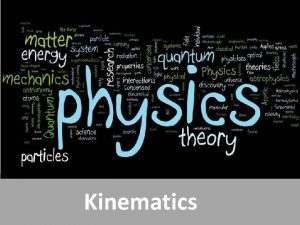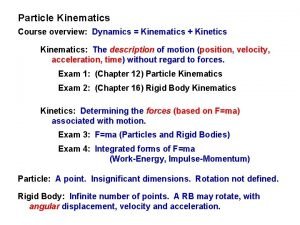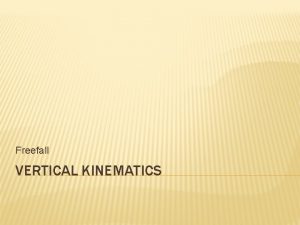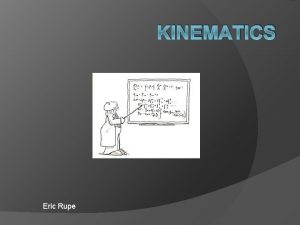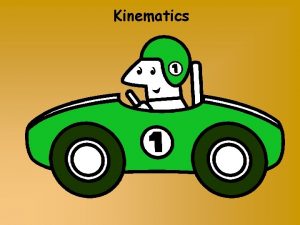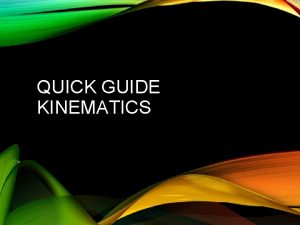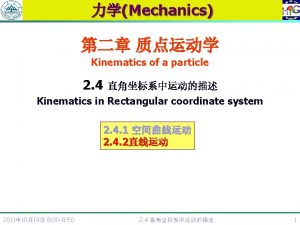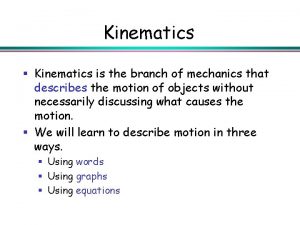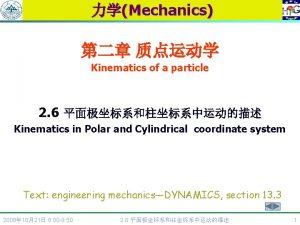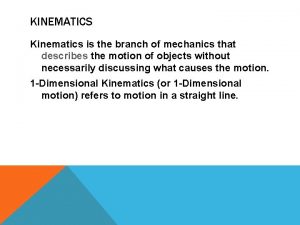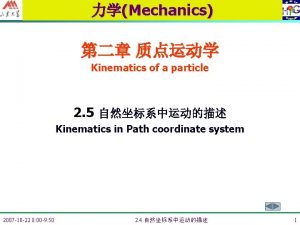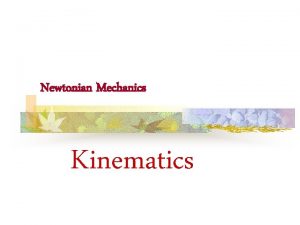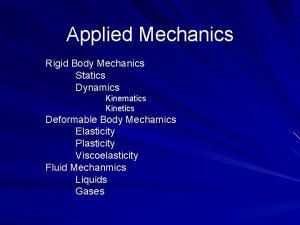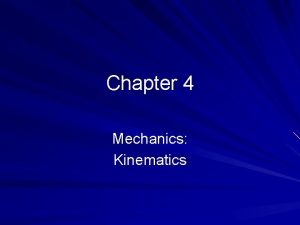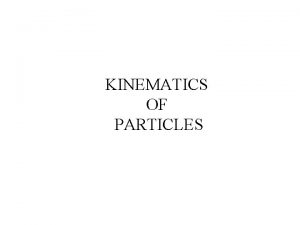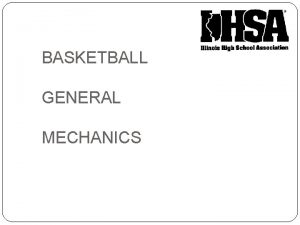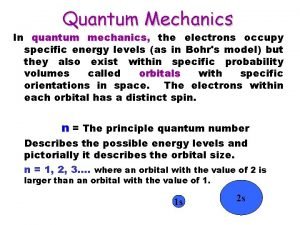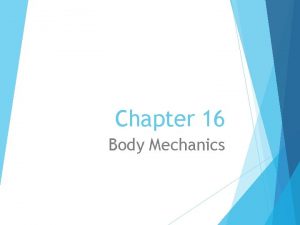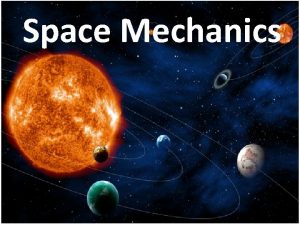Theoretical Mechanics 3 1 Lecture 3 Kinematics of































- Slides: 31

Theoretical Mechanics (3. 1) Lecture 3. Kinematics of the rigid body 1

Theoretical Mechanics The solid bodies are approximately rigid, their shape does not change if we stretch, compress or torque them. Clearly, this is never rigorously true, because small deformations always take place. Several dynamical properties of these bodies can be studied considering them as rigid. The space location (3 D) of a rigid body is called its configuration, which is the set of the positions of its points. • The space location of a material point need 3 coordinates (Degree of Freedom) • To define the configuration of a generic system of N points, we need 3 N coordinates. Lecture 3. Kinematics of the rigid body 2

Theoretical Mechanics • Five degree of freedom has for a rigid system formed by two points • Only six coordinates are necessary for a rigid body (6 Do. F). Indeed, for a three points rigid system 3 x 3 coordinates – 3 rigid conditions = 6 coordinates (6 Do. F) are necessary. We suppose that for a N-1 points rigid system 6 coordinates are necessary and we’ll prove that this is also true for a N points rigid system. By introducing a new point, we have 9 coordinates. But, taking into account the rigidity condition for three arbitrary non-collinear points the degrees of freedom are reduced to 6. Once you know the distances between mass point m. I and three non-collinear reference mass points (e. g. , m 1, m 2, m 3), then you’ve fixed its position relative to all the other mass points. Lecture 3. Kinematics of the rigid body 3

Theoretical Mechanics The position and the motion of the mobile frame of reference (i. e. the rigid body) is determined by 6 parameters (coordinates). Lecture 3. Kinematics of the rigid body 4

Theoretical Mechanics Lecture 3. Kinematics of the rigid body 5

Theoretical Mechanics Lecture 3. Kinematics of the rigid body 6

Theoretical Mechanics Lecture 3. Kinematics of the rigid body 7

Theoretical Mechanics Lecture 3. Kinematics of the rigid body 8

Theoretical Mechanics Lecture 3. Kinematics of the rigid body 9

Theoretical Mechanics The Tait-Bryan angles (φ, , ψ) are most often used to describe the orientation of an aircraft (or similar object), and in such a context go by the names yaw, pitch, and roll, or heading, elevation, and bank. Yaw or heading specifies the left-right direction of the aircraft; Pitch or elevation specifies whether the aircraft is ascending or descending; Roll or bank specifies if the aircraft has any rotational motion (spin) about its direction of motion. Lecture 3. Kinematics of the rigid body 10

Theoretical Mechanics The equations of motion for the rigid body are: (3. 2) The motion determined by 6 independent parameters (6 Do. F) is the most general motion of the rigid body. Lecture 3. Kinematics of the rigid body 11

Theoretical Mechanics We have to find Lecture 3. Kinematics of the rigid body 12

Theoretical Mechanics (3. 3) z y from where x Lecture 3. Kinematics of the rigid body 13

Theoretical Mechanics Thus, taking into account (3. 3), we can use the following notations (3. 4) and we have Lecture 3. Kinematics of the rigid body 14

Theoretical Mechanics These relations are the Poisson’s formulas (3. 5) Lecture 3. Kinematics of the rigid body 15

Theoretical Mechanics Consider such that Lecture 3. Kinematics of the rigid body 16

Theoretical Mechanics (3. 6) Thus Comparing the formulas (3. 7) Lecture 3. Kinematics of the rigid body 17

Theoretical Mechanics Lecture 3. Kinematics of the rigid body 18

Theoretical Mechanics Velocity is given by (4. 1) where (4. 2) Lecture 3. Kinematics of the rigid body 19

Theoretical Mechanics (4. 3) Remark. Equation (4. 2) gives the distribution of velocities in the rigid body. The characteristics of the velocity are: Lecture 3. Kinematics of the rigid body 20

Theoretical Mechanics Acceleration Thus, (4. 4) Lecture 3. Kinematics of the rigid body 21

Theoretical Mechanics Consider (4. 5) Thus, (4. 6) Lecture 3. Kinematics of the rigid body 22

Theoretical Mechanics Translation of the rigid body In every moment of the motion we have (4. 7) (4. 8) (4. 9) Lecture 3. Kinematics of the rigid body 23

Theoretical Mechanics Translation of the rigid body Lecture 3. Kinematics of the rigid body 24

Theoretical Mechanics Velocity and acceleration: (4. 10) Remark. The motion of translation of a rigid body reduces to the translation of the point O. All the points of the rigid body have the same velocity and acceleration. Definition. If at a moment t we have then the motion of the rigid body is an instantaneous translation. Remark. According to the eq. (4. 7) and the previous definition the translation of a rigid body is a succession of instantaneous translation. Lecture 3. Kinematics of the rigid body 25

Theoretical Mechanics Rotation around a fixed axis In every moment of the motion we have (4. 11) Lecture 3. Kinematics of the rigid body 26

Theoretical Mechanics Equation of the motion: (4. 12) Velocity and acceleration: (4. 13) (4. 14) Lecture 3. Kinematics of the rigid body 27

Theoretical Mechanics Example (4. 14) Lecture 3. Kinematics of the rigid body 28

Theoretical Mechanics Lecture 3. Kinematics of the rigid body 29

Theoretical Mechanics Lecture 3. Kinematics of the rigid body 30

Theoretical Mechanics Lecture 3. Kinematics of the rigid body 31
 Aplusphysics kinematics-horizontal kinematics
Aplusphysics kinematics-horizontal kinematics Fluid kinematics definition
Fluid kinematics definition Theoretical mechanics
Theoretical mechanics 01:640:244 lecture notes - lecture 15: plat, idah, farad
01:640:244 lecture notes - lecture 15: plat, idah, farad Tempus robotics
Tempus robotics Dr frost further kinematics
Dr frost further kinematics Aplusphysics kinematics-free fall
Aplusphysics kinematics-free fall Kinematics
Kinematics Coriolis acceleration formula
Coriolis acceleration formula What is kinematics
What is kinematics Kinematics
Kinematics Transport theorem kinematics
Transport theorem kinematics Graphic statics
Graphic statics Kinematics ib physics
Kinematics ib physics Kinematics
Kinematics Dh convention
Dh convention Kinematics and dynamics of machines
Kinematics and dynamics of machines Iczv
Iczv Fbd and kd
Fbd and kd Kinematics
Kinematics Linear and angular kinematics
Linear and angular kinematics Arnold kennedy theorem
Arnold kennedy theorem Rectilinear kinematics
Rectilinear kinematics Kinematics of a particle
Kinematics of a particle Kinematics-defining motion
Kinematics-defining motion A level physics kinematics
A level physics kinematics Kinematics definition
Kinematics definition Chapter 12 kinematics of a particle solutions
Chapter 12 kinematics of a particle solutions Projectile motion equations
Projectile motion equations Kinematics equations
Kinematics equations Inverse kinematics
Inverse kinematics Kinematics
Kinematics


